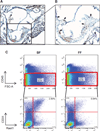Altered expression of Raet1e, a major histocompatibility complex class 1-like molecule, underlies the atherosclerosis modifier locus Ath11 10b
- PMID: 23948654
- PMCID: PMC3938025
- DOI: 10.1161/CIRCRESAHA.113.302052
Altered expression of Raet1e, a major histocompatibility complex class 1-like molecule, underlies the atherosclerosis modifier locus Ath11 10b
Abstract
Rationale: Quantitative trait locus mapping of an intercross between C57.Apoe⁻/⁻ and FVB.Apoe⁻/⁻ mice revealed an atherosclerosis locus controlling aortic root lesion area on proximal chromosome 10, Ath11. In a previous work, subcongenic analysis showed Ath11 to be complex with proximal (10a) and distal (10b) regions.
Objective: To identify the causative genetic variation underlying the atherosclerosis modifier locus Ath11 10b.
Methods and results: We now report subcongenic J, which narrows the 10b region to 5 genes, Myb, Hbs1L, Aldh8a1, Sgk1, and Raet1e. Sequence analysis of these genes revealed no amino acid coding differences between the parental strains. However, comparing aortic expression of these genes between F1.Apoe⁻/⁻ Chr10SubJ((B/F)) and F1.Apoe⁻/⁻ Chr10SubJ((F/F)) uncovered a consistent difference only for Raet1e, with decreased, virtually background, expression associated with increased atherosclerosis in the latter. The key role of Raet1e was confirmed by showing that transgene-induced aortic overexpression of Raet1e in F1.Apoe⁻/⁻ Chr10SubJ((F/F)) mice decreased atherosclerosis. Promoter reporter constructs comparing C57 and FVB sequences identified an FVB mutation in the core of the major aortic transcription start site abrogating activity.
Conclusions: This nonbiased approach has revealed Raet1e, a major histocompatibility complex class 1-like molecule expressed in lesional aortic endothelial cells and macrophage-rich regions, as a novel atherosclerosis gene and represents one of the few successes of the quantitative trait locus strategy in complex diseases.
Keywords: atherosclerosis; gene expression; genetic susceptibility; mice; mouse model; quantitative trait loci.
Figures






Comment in
-
Genetics of common forms of heart disease: a long and winding road.Circ Res. 2013 Oct 12;113(9):1035-6. doi: 10.1161/CIRCRESAHA.113.302425. Circ Res. 2013. PMID: 24115066 Free PMC article. No abstract available.
Similar articles
-
The mouse atherosclerosis locus at chromosome 10 (Ath11) acts early in lesion formation with subcongenic strains delineating 2 narrowed regions.Arterioscler Thromb Vasc Biol. 2010 Aug;30(8):1583-90. doi: 10.1161/ATVBAHA.110.205757. Epub 2010 May 13. Arterioscler Thromb Vasc Biol. 2010. PMID: 20466976 Free PMC article.
-
Genetic-genomic replication to identify candidate mouse atherosclerosis modifier genes.J Am Heart Assoc. 2013 Jan 23;2(1):e005421. doi: 10.1161/JAHA.112.005421. J Am Heart Assoc. 2013. PMID: 23525445 Free PMC article.
-
Characterization of Ath29, a major mouse atherosclerosis susceptibility locus, and identification of Rcn2 as a novel regulator of cytokine expression.Am J Physiol Heart Circ Physiol. 2011 Sep;301(3):H1056-61. doi: 10.1152/ajpheart.00366.2011. Epub 2011 Jun 10. Am J Physiol Heart Circ Physiol. 2011. PMID: 21666121 Free PMC article.
-
Aortic Cellular Heterogeneity in Health and Disease: Novel Insights Into Aortic Diseases From Single-Cell RNA Transcriptomic Data Sets.Hypertension. 2024 Apr;81(4):738-751. doi: 10.1161/HYPERTENSIONAHA.123.20597. Epub 2024 Feb 6. Hypertension. 2024. PMID: 38318714 Review.
-
Genetic and genomic insights into the molecular basis of atherosclerosis.Cell Metab. 2007 Sep;6(3):164-79. doi: 10.1016/j.cmet.2007.07.001. Cell Metab. 2007. PMID: 17767904 Free PMC article. Review.
Cited by
-
Raet1e Polymorphisms Are Associated with Increased Risk of Developing Premature Coronary Artery Disease and with Some Cardiometabolic Parameters: The GEA Mexican Study.Mediators Inflamm. 2018 Dec 18;2018:1847696. doi: 10.1155/2018/1847696. eCollection 2018. Mediators Inflamm. 2018. PMID: 30662365 Free PMC article.
-
Genetics of common forms of heart disease: a long and winding road.Circ Res. 2013 Oct 12;113(9):1035-6. doi: 10.1161/CIRCRESAHA.113.302425. Circ Res. 2013. PMID: 24115066 Free PMC article. No abstract available.
-
Identification and validation of immune-related gene signature models for predicting prognosis and immunotherapy response in hepatocellular carcinoma.Front Immunol. 2024 Jun 12;15:1371829. doi: 10.3389/fimmu.2024.1371829. eCollection 2024. Front Immunol. 2024. PMID: 38933262 Free PMC article.
-
From Peas to Disease: Modifier Genes, Network Resilience, and the Genetics of Health.Am J Hum Genet. 2017 Aug 3;101(2):177-191. doi: 10.1016/j.ajhg.2017.06.004. Am J Hum Genet. 2017. PMID: 28777930 Free PMC article. Review.
-
Identification of Immune Cells and Key Genes associated with Alzheimer's Disease.Int J Med Sci. 2022 Jan 1;19(1):112-125. doi: 10.7150/ijms.66422. eCollection 2022. Int J Med Sci. 2022. PMID: 34975305 Free PMC article.
References
-
- Libby P, Ridker PM, Hansson GK. Progress and challenges in translating the biology of atherosclerosis. Nature. 2011;473:317–325. - PubMed
Publication types
MeSH terms
Substances
Grants and funding
LinkOut - more resources
Full Text Sources
Other Literature Sources
Medical
Molecular Biology Databases
Miscellaneous

